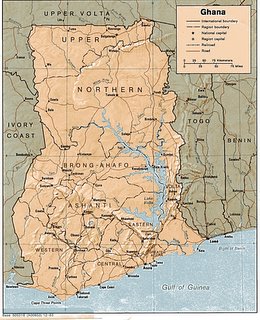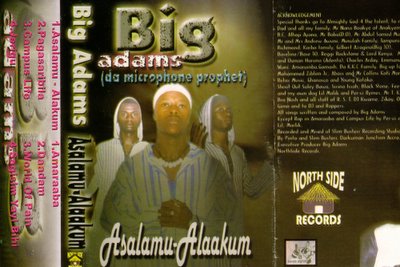Monday, February 20, 2006
Dusty, Heavily Islamic Northern Ghana: Hip-Hop Up There?

Ghana is a big country. Well, it's actually not that big (it's only about the size of Pennsylvania or Oregon), but it has a whole lot of distinct regional flavors for sure. Most of the music discussed on The Hiplife Complex comes from the southern third of the country. Most of the major cities are there, down by the coast in most cases. But what about the rest? What does life sound like up there in the North?
Things are quite different in Northern Ghana. The air is dry. It's usually quite hot. And, the landscape is sparsely occupied by a mix of scrawny trees, fields of yams, which are individually planted in little conical mounds, and round houses built sporadically in clustered compounds. Northern Ghana is home to most of the country's Muslims. Linguistically and culturally, this part of the country has more in common with Burkina Faso and Southern Mali. But, thanks to Africa's colonial legacy, this region belongs to Ghana, and therefore reflects an enormous amount of Ghanaianness, no matter how you cut it.

Not surprisingly, there's enough localized hip-hop, hiplife, and reggae up there to warrant a full investigation. So that's what I did. Beginning with my first foray into the North in 2002, a larger town called Tamale to be exact, I made friends with a whole crew of musicians and artists. Intertwining the sounds and styles of Greater Ghana eminating from urban centers Accra and Kumasi (located 8 and 12 hours down the road respectively) with the long-standing sensibilities distinctive of their Sahel-side region, these artists are consciously creative whilst lying at the fringe of Ghana's commercial music industry. Although some of Tamale's musicians have numerous albums to their credit, pack clubs around the region, and can be heard on all the radio stations in the area, the vast majority of their songs have never been heard (much less heard of) by the rest of Ghana.
Why the separation between Northern and Southern music/musicians?
It's a long story that I certainly don't have down pat, but, for starters, the British underdeveloped that part of the territory from the very beginning of colonialism. While the area beginning at the coast to just north of Kumasi (more or less the center of Ghana) was valuable in terms of resources like gold, bauxite, and timber, the dusty North was not a big concern. While the south became peppered with churches and schools and railways and roads, the North was left to itself. Islam took hold and long-standing socio-linguistic closeness to peoples of Burkina, Mali, and Togo kept Northern Ghanaians in a completely different bag, creatively and aesthetically. It was only later, as Ghana built up nationalistic steam during the post-independence period of the late-50s and early 1960s, that northern towns like Tamale, Bolgatanga, and Wa were reallyincluded in the new and diverse identity of Africa's first post-colonial nation-state.
Once Ghana had galvanized as a country, cultural and artistic concepts from the populous southern ethnic groups like the Asante and Ewe became dominant. So, Northerners heard highlife music from early on. They saw concert parties perform in remote Northern villages, as groups from Accra and Kumasi would travel far for audiences in those days. But the people of the three Northern regions (part of Ghana's 10 region system) had their own performance genres and traditions, not mention languages, religious practices, and family systems. At the time, Northerners (I use "Northerners" for expediency's sake, there are many distinct groups in the North) were creating and consuming a vast pallate of praise music, traditional dances, and even their own interpretations of popular highlife and foreign styles. Through Ghana Broadcasting Corporation, founded in 1935, everyone in Ghana theoretically had access to the same sounds. Of course, for people in the rural north, where there were few radios, there was less contact with cosmopolitan musical movements.
The first cassette release to include rap in Dagbani, the North's most commonly-spoken language, was a track on Sirina Issa's debut Cheer The Stars. The "Godfather" of Dagbani-language rap is Big Adams. Adams was only a kid when he was featured on Issah's incredibly surreal-sounding ode to Ghana's national football (soccer) team, the Black Stars. To me, this album is nothing short of genius. Primitive beats that are at once funky and cute, along with Sirina's almost grating vocals, make for a singular experience. Backing vocals by a ragtag cast of basically neighborhood kids make it sound like "outsider" music by people obsessed with early Prince and Stacy Q.
Considering how new to Northern ears these kinds of sounds were at the time, this recording is important. Down South, they'd been releasing plenty of records with hip, electronic beats for a long time, but the lyrics were almost always in Twi. With Cheer The Stars, Issah invented a new landscape for music in Tamale. This album was a hit up there, with the track featuring this new vernacular rapping hitting particularly hard. Recorded in 1993, released in 1994, people had been hearing rap in Twi for a few years now, here and there. But, for the youth of Tamale, rap in Dagbani was novel.
Below is the cassette cover, complete with spelling errors and amazing cut and paste design:

Big Adams evenutally put out his own debut on North Side Records a few years later. Nicknamed "Da Microhpone Prophet," Big Adams's name is unanimously invoked when discussing the roots of hiplife in the North. His album, entitled Asalamu-Alaakum, made clear the distinct identity he wanted for rap from the North (the phrase is a greeting used across the Muslim world).
This is the cover of Big Adams' first full-length. Note the Northern-style cloth, Muslim cap and prayer pose:

Big Adams today:


Watch a snippet of my interview with Big Adams, "Da Microphone Prophet"
The music stressed the melismatic vocal style found across the Sahel, something that brings closer to mind faraway Morocco or Egypt more than the predominately Christian Southern Ghana. Musically, Big Adams and his colleagues created a sound that blends equal parts higlife, indigneous praise singing (which utilize hourglass-shaped tension drums played under the arm with one hand), and Bollywood.
Why Bollywood? If you take a walk around any market in Northern Ghana, or Burkina or Mali for that matter, you'll find a good number of Bollywood videos and CDs for sale. For some reason, Bollywood has made headway in this unlikeliest of areas, where it is not uncommon get in a taxi or sit in a restaurant and listen to/watch Bollywood music/movies. Few in the South have interest in Bollywood, making this aspect of Northern hiplife a particularly unique element.
Again, the musical sensibilities relate more to the music of Mali and Burkina Faso, than of what you may hear on national radio. But, since radio became privatized throughout Ghana in the mid-1990s, Tamale-based stations promoted the new Northern hiplife songs. This music would never be heard or appreciated in the South, except in the handful of urban slums in Accra and Kumasi inhabited by Northerners.
More on all this to come...
Check out this article on Northern Music Awards in Tamale last December
Comments:
<< Home
Obibinii hollers for Northern-Ghana!! Ain't no place more peaceful than Tamale. Wa is too much of a trade centre. The town of Lawra next to Ivory Coast is the place to be in the North-West. Beyin rules in the South-West Coast! Please share some money for the East. Ho pick-up!
I fell in love with High-Life, much appreciated for keeping me and my readers informed!!
My friend, you've been linked.
I'm sure you know Fanthom radio...
http://sankofa.mine.nu:443/
I fell in love with High-Life, much appreciated for keeping me and my readers informed!!
My friend, you've been linked.
I'm sure you know Fanthom radio...
http://sankofa.mine.nu:443/
Yaw, how are you?
was doing similar MA-research during same time (dec03-may04) but mainly in Accra. I cant find (parts of) your thesis on the website. Maybe it hasnt been finalized yet? Would be interested to see what youve come up with.
If you're interested you can dload my thesis and get some additional info at www.bamflash.com
cheers,
Erik
Post a Comment
was doing similar MA-research during same time (dec03-may04) but mainly in Accra. I cant find (parts of) your thesis on the website. Maybe it hasnt been finalized yet? Would be interested to see what youve come up with.
If you're interested you can dload my thesis and get some additional info at www.bamflash.com
cheers,
Erik
<< Home

